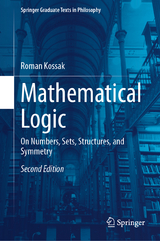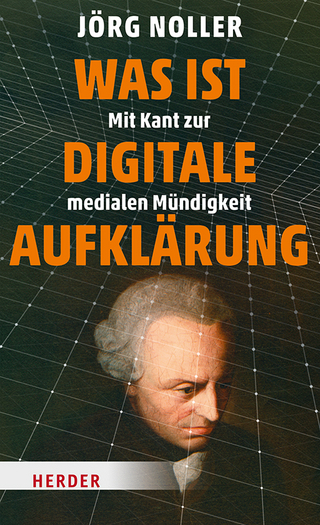
Mathematical Logic
Springer International Publishing (Verlag)
978-3-319-97297-8 (ISBN)
- Titel erscheint in neuer Auflage
- Artikel merken
This book, presented in two parts, offers a slow introduction to mathematical logic, and several basic concepts of model theory, such as first-order definability, types, symmetries, and elementary extensions.
Its first part, Logic Sets, and Numbers, shows how mathematical logic is used to develop the number structures of classical mathematics. The exposition does not assume any prerequisites; it is rigorous, but as informal as possible. All necessary concepts are introduced exactly as they would be in a course in mathematical logic; but are accompanied by more extensive introductory remarks and examples to motivate formal developments.
The second part, Relations, Structures, Geometry, introduces several basic concepts of model theory, such as first-order definability, types, symmetries, and elementary extensions, and shows how they are used to study and classify mathematical structures. Although more advanced, this second part is accessible to the reader who is either already familiar with basic mathematical logic, or has carefully read the first part of the book. Classical developments in model theory, including the Compactness Theorem and its uses, are discussed. Other topics include tameness, minimality, and order minimality of structures.
The book can be used as an introduction to model theory, but unlike standard texts, it does not require familiarity with abstract algebra. This book will also be of interest to mathematicians who know the technical aspects of the subject, but are not familiar with its history and philosophical background.
Roman Kossak is a Professor of Mathematics at the City University of New York. He does research in model theory of formal arithmetic. He has published 36 research papers and co-authored a monograph on the subject for the Oxford Logic Guides series. His other interests include philosophy of mathematics, phenomenology of perception, and interactions between mathematics philosophy and the arts.
Chapter1. Mathematical Logic.- Chapter2. Logical Seeing.- Chapter3. What is a Number?.- Chapter4. Number Structures.- Chapter5. Points, Lines.- Chapter6. Set Theory.- Chapter7. Relations.- Chapter8. Definable Elements and Constants.- Chapter9. Minimal and Order-Minimal Structures.- Chapter10. Geometry of Definable Sets.- Chapter11. Where Do Structures Come From?.- Chapter12. Elementary Extensions and Symmetries.- Chapter13. Tame vs. Wild.- Chapter14. First-order Properties.- Chapter15. Symmetries and Logical Visibility One More Time.
"Remembering how impenetrable textbooks on mathematical logic were when he was a freshman, the author has written an introductory textbook on mathematical logic, whose main strength is the emphasis on motivating every step with detailed explanations. ... The author has clearly succeeded in writing a textbook making the reading of those impenetrable texts possible for a beginner." (Victor V. Pambuccian, zbMATH 06945597, 2021)
"This fun book can be viewed as a very gentle introduction to the notion of mathematical structure, and hence to model theory. ... Each chapter concludes with a selection of exercises of varying degrees of difficulty, often asking the reader to establish facts. Apart from the uses suggested on the book's cover, I can well imagine teaching an introduction to proof class with this textbook." (Jana Maríková, Mathematical Reviews, March 2021)
"The author has made a significant effort to present the (not so easy) material in an understandable way ... . I am sure that readers of this well-written book will experience many such satisfying moments." (Temur Kutsia, Computing Reviews, September 11, 2019)
"Such modesty and humility. Wow. Here is an outstanding book. In the beginning, we learn of the difficulties the author encountered as a student while learning some of the very topics he writes about in this book. So successfully has the author conquered his youthful difficulties that model theory is now his research specialty and is also an important component of this book." (Dennis W. Gordon, MAA Reviews, May 19, 2019)
| Erscheinungsdatum | 20.10.2018 |
|---|---|
| Reihe/Serie | Springer Graduate Texts in Philosophy |
| Zusatzinfo | XIII, 186 p. 28 illus. |
| Verlagsort | Cham |
| Sprache | englisch |
| Maße | 155 x 235 mm |
| Gewicht | 467 g |
| Themenwelt | Geisteswissenschaften ► Philosophie |
| Mathematik / Informatik ► Mathematik | |
| Schlagworte | Abstract symmetries • Applied compactness theorem • Axiomatic set theory • compactness theorem • complexity mathematical structures • first-order logic applications • first-order logic introduction • Formal arithmetic • geometry definable sets • language of modern mathematics • Logical visibility • mathematical structure relations • model Theory • Number system development • Ramsey theory • recent developents model theory • Set theory mathematics • Tameness mathematical structures |
| ISBN-10 | 3-319-97297-9 / 3319972979 |
| ISBN-13 | 978-3-319-97297-8 / 9783319972978 |
| Zustand | Neuware |
| Informationen gemäß Produktsicherheitsverordnung (GPSR) | |
| Haben Sie eine Frage zum Produkt? |
aus dem Bereich



